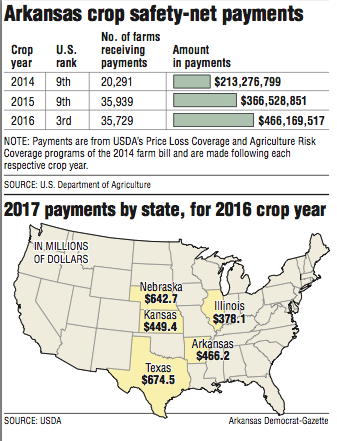Arkansas farmers received $466 million in federal "safety net" payments this year for crop losses in 2016, third-most in the nation, according to the U.S. Department of Agriculture.
This year's payments are $100 million higher than last year's, an increase brought on primarily by low market prices for rice.
"If you grew long-grain rice in Arkansas, you likely got a check," said H. Scott Stiles, an economist with the University of Arkansas System's Agriculture Division but who is based at Arkansas State University.
Arkansas farmers received $213.2 million for losses in 2014.
The 2014 and 2015 payments both were ninth-highest in the country.
The payments are aimed at helping farmers recover some of their losses caused by yield reduction or low commodity prices.
Arkansas is the nation's largest rice producer, so a bad rice market is reflected in the subsidy payments, said Stiles and Anita Wilson, supervisor of farm programs for the USDA's Arkansas Farm Service Agency.
The $466,169,517 in payments this year went to 35,729 farms in Arkansas.
The payments are through two programs in the 2014 farm bill passed by Congress and are separate from what farmers can receive for damage caused by floods and other disasters.
The 2014 farm bill ended years of "direct" payments to farmers -- regardless of market conditions or crop yields -- and required farmers to choose one of two new programs for each of their subsidy-eligible crops:
• Price Loss Coverage, which makes payments when market-year average prices are below certain reference prices determined by the USDA.
• Agricultural Risk Coverage, which creates payment rates for each county in the nation by comparing historical average crop yields and prices in the county with actual yields and prices in the county.
The farmer's decision between the payment programs remains in effect throughout the life of the farm bill. The next farm bill is still being developed in Congress and, if passed, would take effect in 2019.
Many Arkansas farmers don't receive such payments, and some chose not to enroll in either program, said David Curtis, the newly appointed Farm Service Agency state director.
And, of those who do receive payments, they tend to be among the state's largest producers, as reflected in a report released in late November by the USDA's Economic Research Service.
Farmers can receive more than one check because payments are based on prices for each crop, and most farmers grow more than one crop each season.
In Arkansas, the programs primarily cover soybeans, corn, rice and wheat, although payments also have been made for losses in grain sorghum and peanuts. (Cotton losses are covered by a separate program.)
According to the Arkansas Farm Service Agency, the Price Loss Coverage program paid out $390.2 million to 17,172 farms, for an average payment of $22,728. Arkansas farmers enrolled 1.9 million acres of rice in the Price Loss Coverage program, Wilson said.
Agricultural Risk Coverage payments of $75.8 million went to 18,557 farms, for an average of $4,088.
"This is a risk-management tool for farmers," Curtis said. "It doesn't give them a profit or even make them whole. They've already suffered the loss. These payments probably aren't going right back into these guys' back pockets. They're going for this year's purchases of seeds, pesticides, herbicides, even debts from last year's crops."
The three years of Price Loss Coverage and Agricultural Risk Coverage payments in the current farm bill reflect the difficulties of the agriculture market.
Last year, when Arkansas farmers received $366.5 million under the two programs, corn, long-grain rice and soybeans were the top three subsidized crops. Nationally, low prices for wheat and corn resulted in the largest safety-net payments going to farmers in Illinois, Nebraska, Iowa and Indiana. Illinois farmers, for example, received $923.2 million last year.
Payments in 2015 in Arkansas reflected lower market prices in the previous year for long-grain rice, corn and soybeans, respectively.
Nationally, the USDA said the Price Loss Coverage and Agricultural Risk Coverage payments this year to some 750,000 producers will total $8 billion for the 2016 crop year, including $850 million in rice payments at a subsidy of $1.83 per bushel for long grain.
Other covered commodities include barley, canola, large and small chickpeas, crambe, flaxseed, lentils, mustard seed, oats, dry peas, rapeseed, safflower seed, and sesame and sunflower seed.
The 2014 farm bill was debated at a time when commodity prices were reaching all-time highs from 2011 through 2013 and farm incomes were rising. Ending the direct payments would save taxpayers some $23 billion over 10 years, according to the bill's drafters.
Instead, crop prices started declining in 2015, and subsidy payments rose accordingly, ultimately costing $7.5 billion more than projected between 2016 and 2018, according to the Congressional Budget Office.
Next year's payouts may be lower because commodity prices are somewhat higher, the USDA said last week in its latest farm income forecast.
Overall, net farm income is stabilizing and is expected to provide a small bump in 2017 to $63.2 billion, or a 2.7 percent increase over 2016 numbers. The increase in the overall farm sector comes after three consecutive years of declines.
Still, when factoring in inflation, net farm income -- a broad measure of farm profits -- is relatively unchanged from a year ago, the USDA said.
"Farmers would much rather have the higher crop prices than these payments," Curtis said.
SundayMonday Business on 12/10/2017
